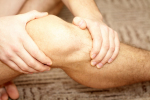- FreeTrainers.com Forums
- Injuries & Rehabilitation
- Shin Splint Relief
Group: Injuries & Rehabilitation
Created: 2012/01/01,
Members: 54,
Messages: 4465
Dealing with injuries and learning how to avoid them is extremely important!
Join group
 Shin Splint Relief
Shin Splint Relief

Ravenbeauty
Posts:
3,755
Joined: 2002/09/24  |
2005/08/24, 07:52 AM
Here was an interesting article I found on this and thought I would share it since I seem to have acquired these symptoms a lot more since bicycling.
---------------------------------------------- How to Manage Shin Splints What are shin splints? The term "shin splints" has been widely used as a catch-all term referring to a collection of different conditions that cause leg pain. The term medial tibial stress syndrome (MTSS) better defines the injury and separates it from injuries such as stress fractures or compartment syndrome. MTSS is caused by chronic strain, overuse, and microtrauma of the soleus (calf) muscle at its origin on the shinbone (posteromedial tibia) or deep inflammation of the periosteum, which is the connective tissue that covers the bone, of the tibia beneath the posterior tibialis muscle (Fig.). MTSS usually occurs in unconditioned people who begin a new running or jumping activity or conditioned runners who change or increase their speed or distance or change their type of shoe or running terrain. MTSS also affects individuals who have flat feet because the mechanics of the foot increase stress on the soleus muscle. MTSS or stress fracture? A patient with MTSS has pain at the inner portion of the tibia in the middle of the lower leg and in the surrounding soft tissue (Fig.). A patient with a stress fracture feels pain around the upper outside portion of the tibia. With MTSS, pain usually disappears once the activity that causes the pain is reduced or stopped. With a stress fracture, however, the patient usually experiences pain that does not go away with rest. The pain often persists with walking and increases when walking up steps or during similar moderate activity. The patient often complains of pain at night. A "one-leg hop test" is a functional test often used to distinguish between MTSS and a stress fracture. A patient with MTSS can hop at least 10 times on the affected leg; however, a patient with a stress fracture cannot hop without severe pain. An x-ray sometimes show chronic cases of MTSS, where there is a mild thickening or an uneven edge at the end of the tibia in the back. X-rays are also often taken to rule out a stress fracture. However, x-rays may not show a fracture line or a healing stress fracture until several weeks after injury, so a bone scan, computed tomography (CT) scan or magnetic resonance imaging (MRI) scan may be used instead. How to treat MTSS To relieve the pain caused by MTSS, ice massage and Achilles tendon stretching are performed 3 to 4 times a day. Nonsteroidal anti-inflammatories such as aspirin are recommended to relieve inflammation and pain. Gentle stretching of the leg muscles that includes the calf, heel cord, and hamstring is essential before and after exercising to treat MTSS. Any anatomic foot variation, such as a pronated (a foot with a low arch) flat foot, should be corrected with a semirigid foot orthosis (shoe insert). Runners should use a running shoe that provides shock absorption and has a firm heel support. Gentle flexibility and strengthening exercises for the muscles involved should also be added to the workout. The key treatment for MTSS is rest from the activity that causes the pain. Once the pain has subsided, less stressful exercise can begin. For example, for the first week, biking and swimming can be substituted for running. Then the patient can start training again at about half the previous level of intensity (half the distance or pace). The exercise intensity should be gradually increased to the desired level over 3 to 6 weeks. Recurrence of pain is a signal that the level of activity has been resumed too fast. Active individuals who have recurring MTSS need not stop exercising or running. They should first correct predisposing factors, such as wearing worn-out shoes, running on hard surfaces and pavement, or increasing training too quickly. If the pain does not subside with these changes and a reduction of activity, then a visit to their orthopaedist is warranted. Rarely, if the symptoms do not respond with long periods of rest, a patient may undergo surgery to release the soleus attachment to the tibia. Usually after surgery, the patient may walk as tolerated, and activity is gradually increased over the following 3 months. MTSS can be painful but is usually easily resolved. If you experience pain in your shin, thoroughly stretch before exercising, reduce your activity level, and check your shoe wear. If you run on a hard surface, find softer ground. Remember, exercising should be fun, not a painful experience. Steven K. Below, M.D. Columbus, Georgia Further Reading: Perrin DH. The Injured Athlete. 3rd ed. Philadelphia, PA: Lippincott-Raven; 1999:423-424. -------------- Bettia.... The secret of getting ahead is getting started. ravenbeauty@freetrainers.com |
|
| |

bropie
Posts:
1,084
Joined: 2004/12/04  |
2005/08/24, 08:40 AM
great post raven!
|

Kalanchoe
Posts:
400
Joined: 2003/02/18  |
2005/09/07, 11:06 AM
I always, absolutley guaranteed, get shin splints for 2 weeks after using a running machine for a few days, really bad ones, so i cant even walk. However, running cross country, i have no problems whatsoever! -------------- each to their own |

flyonthewall
Posts:
1,823
Joined: 2005/01/18  |
2005/09/07, 02:03 PM
kalanchoe, just out of curiousity, when you use the running machine (I'm assuming you mean a treadmill) do you have it inclined or on a hills type program? This can really effect your shins. Try running with the treamill flat.-------------- Even if you are on the right track, you will get run over if you just sit there. |

Kalanchoe
Posts:
400
Joined: 2003/02/18  |
2005/09/08, 03:43 AM
Yep, always with it flat. Fortunately for my shines, i no longer use treadmills, only x-country running. Treadmills bore me to death!-------------- each to their own |

flyonthewall
Posts:
1,823
Joined: 2005/01/18  |
2005/09/08, 09:18 AM
I hear ya on the boredom of the treadmill, but in the middle of January when its -25 with a windchill of -40 I get over the boredom. OMG I can't believe I just put that awful image of Jan. in my head:(..think sun, think sun.....-------------- Even if you are on the right track, you will get run over if you just sit there. |

Ravenbeauty
Posts:
3,755
Joined: 2002/09/24  |
2005/09/08, 10:56 PM
I love cold...hehe
-------------- Bettia.... You will only be remembered for the things that you finish, not the things that you start! ravenbeauty@freetrainers.com |

Kalanchoe
Posts:
400
Joined: 2003/02/18  |
2005/09/09, 03:47 AM
yeah, i much prefer to run in the cold and the rain. I breathe much easier and I'm more comfortable. Even on a reasonably balmy day, i get uncomfortably hot. I'm gonna start cross country fartlek in the next week.-------------- each to their own |

annmarie140
Posts:
24
Joined: 2004/08/28  |
2005/12/05, 11:19 AM
Oh I need this article, thanks!
I was also told to spell the alphabet with my toes pointed and eat banana's. It helps! |

Nyxtikal
Posts:
268
Joined: 2005/09/20  |
2005/12/20, 01:29 AM
I get really bad shin splints and what used to help me when i was running was wearing really tight knee-high socks. i dont know if anyone else has ever tried this, but it always worked well for me.
|

Dwight_32
Posts:
3
Joined: 2006/01/10  |
2006/01/13, 01:49 AM
I actually have bad chin splints aswell, from playing hockey and i ahve been having really lot of troubles i cant even do any long walking or my chins really start to hurt, or i will end doing a hick with the slightest incline omg the pain and i ahve to stop ever 50 steps jsut to let the pain ease up to continue its very anoying, i have tried massaging them adn streching before the walk or what not but i just still keep getting the pain, its so iratating and i love to run and walk lots, i even changed my shoes, but i dont know, i have a bad arch on my left foot i cant wear a high arch in my shoe on tha tone i need to wear flat souled shoes, frustration...
|

Ravenbeauty
Posts:
3,755
Joined: 2002/09/24  |
2006/01/13, 02:35 PM
sorry guy, but what is up with the spelling???? get spell check please.-------------- Bettia.... You will only be remembered for the things that you finish, not the things that you start! ravenbeauty@freetrainers.com |

sailor1029
Posts:
76
Joined: 2003/05/12  |
2006/01/31, 06:21 PM
Are there any exercises that can be done to help with shin splits? I went out and spent a fortune on runners at a specialty shop, I stretch constantly, and I rest them as much as I can, but still they keep happening.
-Scott |

thelordreigns
Posts:
1
Joined: 2006/03/13  |
2006/03/13, 01:54 PM
I am trying to find some relief from shin splints, I heard that rapping my shins will stop the pain when I run until the muscles become strong enougt to hand shock that is sent to them while running. Has anyone tried or heard of this?
|

neecee27
Posts:
1
Joined: 2006/04/20  |
2006/04/20, 01:12 PM
Raven, thanks so much for the info. I'm dying here with these stupid shin splints. :(
|

a45shooter
Posts:
1
Joined: 2006/04/29  |
2006/04/29, 10:42 PM
I have MTSS, and I have had it for years. I have had surgery on both of my legs, and as is typical of most people that have had this surgery, I have not returned to presurgery training levels 2 years later. I read the good doc's comments about rest, bla bla bla.
Anyhow, RICE is only going to get you so far. If you are running incorrectly you can rest ice compress and elevate, and then go slow and gradually try to get back to distances again. And then whammo theyre back.. I have found an exercise plan from some brits that they claim will cure MTSS. I havnt done it yet, but I will post it here. I found it on the web but I lost the link. Also I recommend doing alot of reading from alot of different sources about MTSS injuries. I loved to run, this has been the single most depressing thing that has happend to me in my adult life, and it has affected all aspects of my life because running ability and aerobic endurance are key to my livelihood. Anyhow,, here is the text of the MTSS workout. (1) Wall Shin Raises: stand with your back to a wall, with your heels about the length of your feet away from the wall. lean back until your buttocks and shoulders rest against the wall. Dorsiflex both ankles simultaneously, while your heels remain in contact with the ground. Bring your toes as far toward your shins as you can, and then lower your feet back toward the ground, but do not allow your forefeet to contact the ground before beginning the next repeat. Simply lower them until they are close to the ground, and then begin another repetition. Complete about 12 to 15 reps. Once you have finished the reps, maintain your basic position with your back against the wall, dorsiflex your ankles to close to their fullest extent, and then quickly dorsiflex and plantar flex your ankles 15 times over a very small range of motion (smaller than the nearly full range you use for the basic reps; the emphasis here is on quickness). These short, quick ankle movements are called pulses. As you gain strength over time, make the wall shin raises progressively more difficult by advancing from one set of 15 reps to two and then three sets of 15 (for the basic raises and the pulses). It's okay to walk around for 15 to 30 seconds between sets. Once you can quite comfortably complete 3 x 15 of the double-leg raises (both basic and quick), progress to the single-leg wall shin raise. The basic position for this exercise is as before, except that you begin with only one foot in contact with the ground; the other foot rests lightly on the wall behind you. Now, full body weight is on one foot - as it is during running - as you carry out the overall routine, and the exercises are considerably more difficult. Begin with 12 to 15 reps per foot (both for the basic exercise and pulses), and progress to 3 x 15 (basic and pulse) on each foot as your strength increases. There's no need to rest between sets; simply carry out 15 reps on one foot plus pulses, shift over to the other for 15 repetitions and pulses, return to the original foot, and so on until you have completed three sets with each foot. (2) Heel Step-Downs: These are simple but devastatingly effective exercises for preventing medial tibial stress syndrome (MTSS). Begin with a natural, erect body position, with your feet about shoulder-width apart, and then step forward with one foot. The length of the step should be moderate - as though you were walking in your normal manner. When your heel makes contact with the ground, stop the foot from fully plantar flexing, e. g., use your shin muscles to keep the sole of the foot from making contact with the ground. After heel contact, the ball of your foot should descend no more than an inch toward the floor or ground; your foot is held in check by the eccentric contractions of your dorsiflexors (shin muscles). Return your foot to the starting position (back by the other foot), and repeat this basic stepping action a total of 15 times. Then, shift over to the other foot and complete 15 steps. As with the wall shin raises, progress to three sets of 15 reps over time. Once you are the master of the basic heel step-downs, perform the same exercise - but with dramatically longer steps. Using lengthier steps will increase the accelerating forces placed on the dorsiflexors and force them to work more forcefully and quickly, as they must do during running. Start with one set of 15 reps of long steps per foot, and progress to 3 x 15 on each foot over time. Finally, you will be ready to carry out the heel step-downs from a high step, which will increase the forces on your shin muscles to the greatest extent - and build the greatest amount of strength. Use a bench or exercise platform which is about four inches off the ground to carry out your stepping. Aside from beginning each step from a bench, your movements are the same as they are in the basic step-downs; the idea is to land on the heel of the forward foot and then use the shin muscles to prevent the sole of the foot from making contact with the ground. The actual length of the step is moderate at first (you can progress to long steps later). As before, begin with 15 reps per foot, and progress to three sets of 15 reps as you gain strength and coordination. Other exercises to try Both the wall shin raises and heel step-downs can be carried out three to four times a week, along with your other strength-building exercises (you can complete them more often if you've had lots of problems with medial tibial stress syndrome (MTSS) in the past - don't do them to the point of pain, however; naturally, if you are currently suffering from medial tibial stress syndrome (MTSS), be very cautious and progressive with the exertions). Along with these two key exercises, other activities which bolster the shins include walking on toes (with toes pointed straight ahead, out, and in), walking on heels (toes straight, out, and in), skipping on toes (ahead, out, and in), and even skipping on heels (on a soft surface). Remember that any activity which improves the coordination of your ankles - and their strength in various planes of motion - will limit the risk of medial tibial stress syndrome (MTSS). For example, 'dorsiflexion bounces' have value in controlling medial tibial stress syndrome (MTSS). To do them, simply begin jumping vertically and repetitively at close to maximal height, landing in the mid-foot area with both feet and then springing upward quickly after each contact with the ground. The interesting part of this exercise is that you should dorsiflex your ankles - pulling the tops of your feet toward your shins - on each ascent, before plummeting back toward earth and plantar flexing your ankles just before making contact with the ground. Do 10 dorsiflexion bounces, rest for 10 seconds or so, and then repeat. Over time, you can add additional sets and increase the number of reps to 30. When you are really strong and skilled, perform this exercise on just one foot at a time (but only on a low-impact surface). Movement of the foot at the ankle and tarsal joints 'At the very least...you should also stretch each ankle by fully rotating it outward and inward, and by plantar flexing and dorsiflexing it while the foot is pointed both outward and inward' Of course, carrying out our exercises doesn't mean that your risk of medial tibial stress syndrome is absolute zero. If you suddenly change your weekly training volume from three to six hours, for example, something will have to give, and it might well be your shin muscles and tendons. So, be certain to avoid dramatic changes in the frequency, volume, or intensity of your training; always gradually progress to more difficult levels of work. Sports-medicine experts often recommend stretching the ankle area by slowly moving the ankle to 'each' end of its range of motion in the straight-back and straight-ahead plane, e.g., to the fully dorsiflexed and then completely plantar-flexed positions, holding each position for anywhere from five to 60 seconds. The problem with that, of course, is that you are only stretching your muscles in one plane of motion and thus not adequately mimicking the stretching which takes place during running. At the very least, in addition to carrying out the plantar-flexed and dorsiflexed stretches, you should also stretch each ankle by fully rotating it outward and inward - and by plantar flexing and dorsiflexing the ankle while the foot is pointed both outward and inward to various degrees - not just straight ahead. The experts also recommend strengthening the ankle area by adding resistance to the above stretching movements with the use of surgical tubing or elastic bands. That is indeed a way to increase general strength of the ankle, and it will certainly make you stronger when you carry out surgical-tubing exercises in the future. The problem, of course, is that you run with your feet on the ground - not poised in the air in the clutches of elastic bands. So, to fully prepare your ankles and shins for the rigours of running, you're better off focusing on the specific exercises we are recommending. Does stretching actually help to prevent medial tibial stress syndrome? No scientific evidence indicates that it does, but the idea that stretching might be protective is a logical one (overly taut muscles seem more likely to be damaged by pulling forces, compared to relaxed fibres). Don't stretch your ankle area until after your muscles are warm, however; a good time would be after a warm-up and/or at the end of your training session. If you have a case of medial tibial stress syndrome (mild pain crops up during workouts but doesn't seem to slow you down much), trim weekly volume by around 50 per cent, ice and stretch religiously, consider taking non-steroidal anti-inflammatory medica-tions (but only if you are not prone to the gastrointestinal upsets which have been linked with these compounds), and become a devotee of our shin-strengthening exercises (start gradually with them, though, since they can further inflame tender shins if overdone). Use bicycling workouts to maintain fitness. In two to three weeks, you should be ready for your regular training again. If your medial tibial stress syndrome produces sharp pain while you are training, stop all workouts, ice and stretch, take NSAIDS as directed by your sports doctor, and - when pain subsides - systematically begin utilising our exercises, starting with a few two-legged wall shin raises at first and gradually progressing to the others. Use the exercise bike to maintain fitness, and return to normal training in four to six weeks. Remember that if you carry out our shin-splint routine several times a week and refrain from making bizarre and sudden changes in your training, your encounters with medial tibial stress syndrome should become just a memory. |

DEB227
Posts:
1
Joined: 2007/02/10  |
2007/02/10, 02:58 PM
Anyone try orthotics?I was told that It is a biomechanical
problem.(i.e I run funny)I am awaiting my new insoles for my soccer shoes and runners. hoping this will help, My doc also told me the stretches and calf strengthening posted previous will help. |

Ravenbeauty
Posts:
3,755
Joined: 2002/09/24  |
2007/02/11, 06:27 PM
one of my friends went and tried these out. Orthotics, are devices which support and in some cases correct the function of a limb or the torso. She had great results with these, it would be worth researching into if any of the above suggestions don't stop the pain or splints from occuring.
Once again, just another important reason who shoes play such an effective role in leg sports. -------------- Bettia \"Minds are like parachutes; they work best when open.\" - Lord Thomas Dewar |

antiXcore
Posts:
14
Joined: 2007/03/19  |
2007/03/19, 07:50 PM
I get shin splints from walking, treadmill or trails/sidewalks/etc. Walking period, but I have been on bed rest due to an accident I was in. Could they come from just over use after not using them at all?
|

Ravenbeauty
Posts:
3,755
Joined: 2002/09/24  |
2007/03/23, 11:59 AM
That could most likely be your muscles getting used to activity again, give it a couple weeks and if it still continues or worsens , you need to look at other possibilities.-------------- Bettia "Minds are like parachutes; they work best when open." - Lord Thomas Dewar |

emilylouise81
Posts:
4
Joined: 2007/04/09  |
2007/04/09, 11:27 AM
I suffer with shin splints when i run on my treadmill and to be told to rest etc is a complete no no to me.I know i should but im not the type of person to sit there and do nothing!
I cant think of anything more annoying than shin splints that happen over and over again. Im going to try and do some of the excersises written here but dont hold much hope. -------------- Suffering induces perseverance,and perseverance builds character. |

Ravenbeauty
Posts:
3,755
Joined: 2002/09/24  |
2007/04/09, 02:43 PM
well you've lost the battle already with that pessimistic view. Might as well not even try.:(
If you are going to try them, do it with a positive outlook. -------------- Bettia "Minds are like parachutes; they work best when open." - Lord Thomas Dewar |

lynsey1
Posts:
4
Joined: 2007/09/04  |
2007/10/04, 08:32 AM
I did a 40 mile walk about two weeks ago, after about 30 miles I felt pain in the lower part of my leg across my shin. I just blocked out the pain. The next few days I was just generally stiff but thought nothing of it. It has been about two weeks now and the pain has not eased only at rest. I have stopped running on the treadmill and switched to either cycling or the cross trainer! How long before this pain should ease? I find it difficult as I just think block it out and carry on, but I know that does not help matters! Any other tips?:)
|

wrestler125
Posts:
4,619
Joined: 2004/01/27  |
2008/04/13, 11:21 AM
A video is worth a thousand words.
http://www.youtube.com/watch?v=QdTmh5yKdR8 -------------- SQUAT MORE ~Jesse Marunde Blood Guts Sweat Chalk |

bowen94
Posts:
3
Joined: 2008/06/01  |
2008/06/11, 05:57 AM
I'm not sure what problem I have with my calves but every time I start to run or even walk with any intensity my calves start to cramp up and it then spreads around to the muscle around my shins, I then start to get pins and needles all around my lower leg. I have recently started trying to get fit again after a long lay off but have had this problem for at least 7 years, in the past I put it down to over-training as I trained sometimes twice a day with my rugby team, however for the past year I have done very little and the problem hasn't eased. Anyone with any ideas or help with what it could be? thanks
|

cbeach22
Posts:
1
Joined: 2010/01/13  |
2010/01/16, 01:26 PM
Hello, I am new to the site and I have been reading this topic as I get bad shin splints as well. I was doing alot of treadmill work and once the developed I had to shut down for a little over a month. So now I am doing alot of programs on a stationary bike. I live in Ohio so it's kind of hard to go jog when there is ice everywhere in the winter. So thank you all for the suggestions I think I am going to try and get a pair of compression knee highs but for right now I am trying to do alot of bike hoping I can get the muscles string enough to limit the splints.
|
